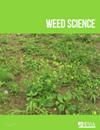Impact of Cereal Rye Cover Crop on the Fate of Preemergence Herbicides Flumioxazin and Pyroxasulfone and Control of Amaranthus spp. in Soybean
IF 2.5
2区 农林科学
Q2 AGRONOMY
引用次数: 0
Abstract
Abstract Preemergence herbicides associated with cereal rye ( Secale cereale L.) cover crop (cereal rye) can be an effective waterhemp [ Amaranthus tuberculatus (Moq.) Sauer.] and Palmer amaranth ( Amaranthus palmeri S. Watson) management strategy in soybean [ Glycine max (L.) Merr.] production. Delaying cereal rye termination until soybean planting (planting green) optimizes biomass production and weed suppression but might further impact the fate of preemergence herbicides. Limited research is available on the fate of preemergence herbicides applied over living cereal rye in the planting green system. Field experiments were conducted in Illinois, Kansas, Pennsylvania, and Wisconsin to evaluate the fate of flumioxazin and pyroxasulfone and Amaranthus spp. residual control under different cover crop management practices in soybean in 2021 and 2022 (8 site-years). A flumioxazin + pyroxasulfone herbicide premix was applied preemergence at soybean planting under no-till without cereal rye, cereal rye early terminated before soybean planting, and cereal rye terminated at soybean planting. Flumioxazin and pyroxasulfone concentrations in the soil were quantified at 0, 7, and 21 d after treatment (DAT) and Amaranthus spp. density was determined at postemergence herbicide application. The presence of cereal rye biomass intercepted flumioxazin and pyroxasulfone at preemergence application and reduced concentration in the soil when compared to no-till, mainly at 0 DAT. Main differences in herbicide concentration were observed between no-till and cereal rye treatments rather than cereal rye termination times. Despite reducing herbicide concentration in the soil, early-season residual Amaranthus spp. control was not affected by the presence of the cereal rye biomass. The adoption of effective preemergence herbicides associated with a properly managed cereal rye cover crop is an effective option for integrated Amaranthus spp. management programs in soybean production systems.谷物黑麦覆盖作物对苗期除草剂氟恶嗪和焦唑砜的影响及对大豆苋属病害的防治
小麦黑麦(Secale cereale L.)覆盖作物(谷类黑麦)的出苗期除草剂可以作为一种有效的水麻[Amaranthus tuberculatus (Moq.)]。萨奥尔。大豆中苋菜(Amaranthus palmeri S. Watson)的管理策略[j]。稳定。)生产。将谷物黑麦的终止推迟到大豆种植(绿色种植)可以优化生物量生产和杂草抑制,但可能进一步影响出生前除草剂的命运。在种植绿色系统中,对活的谷物黑麦施用发芽前除草剂的影响研究有限。在伊利诺斯州、堪萨斯州、宾夕法尼亚州和威斯康星州进行了田间试验,评估了2021年和2022年(8个立地年)不同覆盖作物管理措施下氟恶嗪、吡啶砜和苋属残留防治的效果。采用免耕不播黑麦条件下大豆播种前施用氟恶嗪+焦唑砜除草剂预混剂、黑麦播种前提前终止大豆、黑麦播种后终止大豆。测定了处理后0、7、21 d土壤中氟恶嗪和pyroxasulfone的浓度,并测定了出苗期施用除草剂时苋菜的密度。谷物黑麦生物量的存在在苗期前施用时拦截了氟恶嗪和焦唑砜,并且与免耕相比降低了土壤中的浓度,主要是在0 DAT。除草剂浓度在免耕和黑麦处理之间存在主要差异,而不是在黑麦终止时间之间。尽管降低了土壤中除草剂的浓度,但小麦黑麦生物量的存在对苋属早季残留的控制没有影响。在大豆生产系统中,采用有效的孕前除草剂和适当管理的黑麦覆盖作物是苋属植物综合管理方案的有效选择。
本文章由计算机程序翻译,如有差异,请以英文原文为准。
求助全文
约1分钟内获得全文
求助全文
来源期刊

Weed Science
农林科学-农艺学
CiteScore
4.60
自引率
12.00%
发文量
64
审稿时长
12-24 weeks
期刊介绍:
Weed Science publishes original research and scholarship in the form of peer-reviewed articles focused on fundamental research directly related to all aspects of weed science in agricultural systems. Topics for Weed Science include:
- the biology and ecology of weeds in agricultural, forestry, aquatic, turf, recreational, rights-of-way and other settings, genetics of weeds
- herbicide resistance, chemistry, biochemistry, physiology and molecular action of herbicides and plant growth regulators used to manage undesirable vegetation
- ecology of cropping and other agricultural systems as they relate to weed management
- biological and ecological aspects of weed control tools including biological agents, and herbicide resistant crops
- effect of weed management on soil, air and water.
 求助内容:
求助内容: 应助结果提醒方式:
应助结果提醒方式:


